Fairy Tales & Fables Part 1: Little Red Riding Hood, The Three Billy Goats Gruff, & The Three Little Pigs
There are so many reasons for parents to read fairy tales and fables to young

Jeff Mack (www.jeffmack.com) is a children's author and illustrator. I was introduced to his work a few months ago when my 4-year-old son Harry selected Frog and Fly from a library shelf. Now we are super-fans.
Jeff's picture books, which can feel a bit like graphic novels for preschoolers, generally feature fun animal characters and subtly and deftly explore social-emotional issues. His use of text is as restrained as it is creative; he has books that only use one or two or four words and others that use just two letters! But don't be fooled by the low word count; these are books for preschoolers, not board books for babies or toddlers. They have a lot going on. And the restrained text is ideal for kids who can be overwhelmed by language.
I knew Jeff's unique picture book voice was something I needed to learn more about, so I was thrilled when he agreed to Skype with me last month. You can learn more about Jeff Mack by visiting his website www.jeffmack.com.
MAMA BIBLIOSOPH: So my son Harry loves going to the library, and I’ve been taking him on the weekends. Lately I’ve been doing this thing where I encourage him to pick out his own books. A few months back, he picked out your book, Frog and Fly. It was the first book he ever chose for himself.
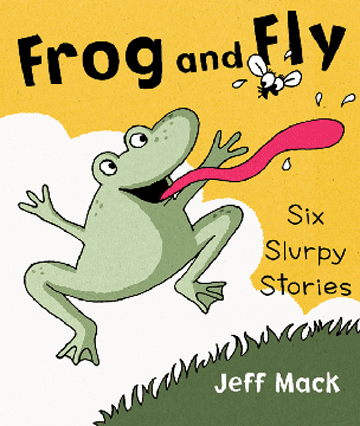
JEFF MACK: Wow! I’m so curious. What do you think drew him to it?
I’m not sure, but I think the illustration on the cover? He loves animals, and I think he generally prefers a cartoon to a more realistic illustration style.
Those are some of the simplest illustrations of any of my books, so that’s very interesting.
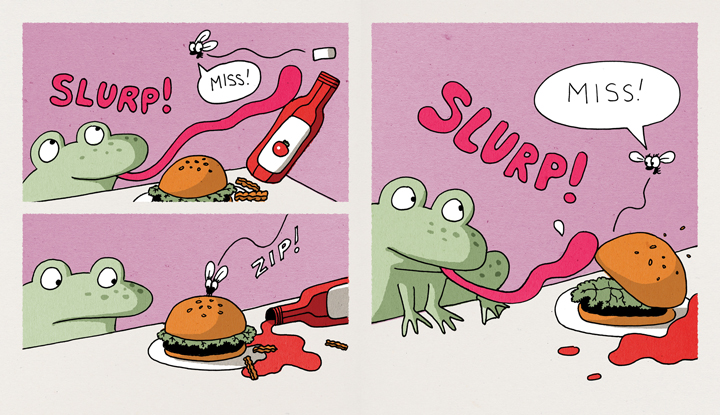
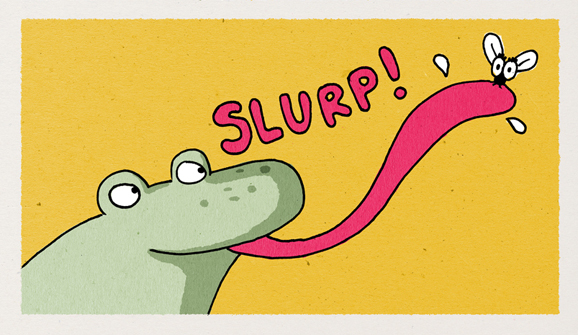
Also, when he opened it up, he recognized some of the words. You don't use a lot of words and they are very easy to read.
He asked me to read it to him. And then he asked me to read it to him again, so you know how that goes. We read it again, and again, and again. Of course we borrowed it from the library, and now we own our very own copy.
Can your son read?
Well, Harry's sight word count is pretty high for a 4-year old, and he can sound things out a bit, but I don’t know how much he actually understands. He can read all the words in Frog and Fly.
Well, that’s sort of a book that was meant to encourage dialoging in the sense that one person can read one of the character’s voices and the other can read the other’s voices. That was my hope.
Yes. And it does work that way for us.
But before we really get into the books, let's back up a bit. I want to know how you came to be a children’s book illustrator and author.
When I was in second grade I had this great teacher who was always coming up with these interesting projects for us to do. One of the projects was to write a Halloween short story. And I asked my teacher if I could write a comic book instead of a short story. And she was pretty open-minded—this was about 1979—and she gave me her permission. Comic books at that time weren’t considered, let’s see how to put this…
"Real" literature?
Pretty much. So it turned out really well. She hung it up on the wall. And all the other kids were checking it out and they had all written short stories, so they started asking me if I could illustrate their stories. So I sort of had this little industry going in second grade, and I got a lot of positive attention from it, and in some ways it’s kind of the same thing today. I’m still making books for kids in second grade—and first grade, and kindergarten, and some older kids too.
In college I started off as an English major, but ended up with a double major in painting and creative writing. I spent a year in Florence, Italy and studied painting and sculpture. After college, I had a bunch of different jobs. One of them was working at a retail store that sold books and music and video games. I was in charge of making these posters that would sell their different projects. Kind of like what they do at Trader Joe’s. So this one day, Pocahontas had just come out on video, and they wanted me to make a display to sell all the different Disney merchandise. So I built this display in the middle of the store with these 2x4s and this huge shaped foam core. It was really intricate. It had Pocahontas and a canoe and John Smith and all these forest animals and trees.
The store manager at the time comes up to me and says, “What do you think your job is at this store?” And I said, “I think it’s to make displays.” And he says, “Oh yeah, and what do you think the displays are meant to do?” So I said, “To sell the products.” And that's when I realize that I hadn’t incorporated the merchandise into the display. I had gotten so immersed in the art. So the display was torn down and it ended up with Pochanotas and a canoe on a table. It was a painful lesson in compromising my artistic vision. I decided I really wanted to do something where I could stick to my vision and I thought children’s books were something I’d like to try. So while I worked odd jobs as a faux finisher and painting some murals, I worked on my own children's book stories in the evenings.
And one day I decided I was ready to take those stories to New York City. I wound up renting an apartment on the Upper East Side.
What year was this?
This would have been ’98. And the apartment was somewhere… I think it was in the 80s between First and York. It was like $300 for a room in a walk-up.
Wow. Nice deal.
It was. So I went to publishing companies on drop-off days. My portfolio at the time was a book dummy. It was a story that I had illustrated that had lots of different kinds of animals and people. Gradually, I got interest in my illustrations, but not in my stories. So I began to get jobs illustrating other people’s stories. Through that, I began to meet different editors and eventually published my first picture book, Hush Little Polar Bear with Neal Porter at Roaring Brook. So that’s the story.
That’s a great story. I like the move-to-NYC hustle part of it!
So now of course I must ask if you have any background with special needs kids. Your books are highly structured, they use a lot of repetition, your illustrations are really high contrast, you don’t use a lot of words, you have a lot of animal characters, and all this physical action and humor. Do you have personal experience with special education? Because you are writing books that are great for kids with a variety of special needs, but certainly for kids with autism.
Well, my mom was a special education teacher. So I would sometimes go into her classes and read books to the kids there. And I volunteered for awhile doing literacy education for kids with learning disabilities. I also worked at an upstate New York art camp for kids for awhile. So I had a lot of different experiences working with kids both reading with them and making art. Gradually, I developed a sense of the accomplishment kids feel when they are able to read something on their own. That seemed really important. I wanted to make books that would help them get there, and help them feel that if they could read this book, maybe they could read something a little tougher, and sort of climb the ladder.
The first book I read on my own was Fox in Socks by Dr. Seuss. I read it in the back of my parents' car, and I remember figuring out how to do it on my own and I was so triumphant.
I think some people looking at your books might mistakenly think they are for a younger audience than you are intending because they have so few words and repeat themselves so much. They are deceptively simple. How did you come to adopt this style?
With those first books that I didn’t sell to publishers, one of the complaints that I heard routinely was that the stories were too complex. They would say “sophisticated.” I guess what they meant was that they were above the comprehension level of the audience they were intended for. It was kind of a regular comment, so I took it to heart.
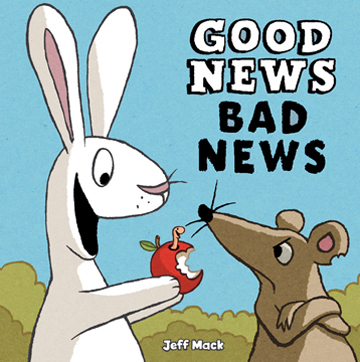
I tried to look at ways to simplify things. Good News, Bad News early on had quite a few words in it. It was a whole conversation between the mouse and rabbit. But I realized more and more that the stories were told by the illustrations. The words were pretty redundant. So I decided to cut out anything I didn’t need. And as I started cutting out words, I began to realize that I needed almost no words. The only thing I couldn’t cut was the theme; the thing that connected the pictures. So the only words left were “good news” and “bad news” the words that describe how the characters are feeling about what's happening.
A few years earlier, I had illustrated a book for Eve Bunting called Hurry Hurry!. It was about animals on a farm who run around saying words like, “Hurry! Hurry!” or “Faster! Faster!” and when she delivered the text to me those were the only words, about 36 in the whole book, with notes saying things like “mother sheep to baby sheep.” I could see that she had a vision of the pictures telling that story. So I think that was the first place that I saw how that all came together and it was so interesting to me.
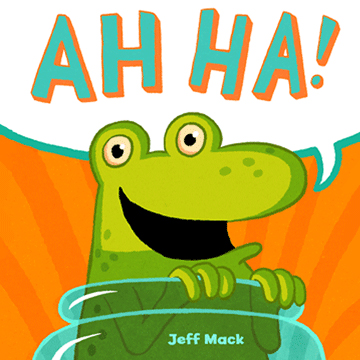
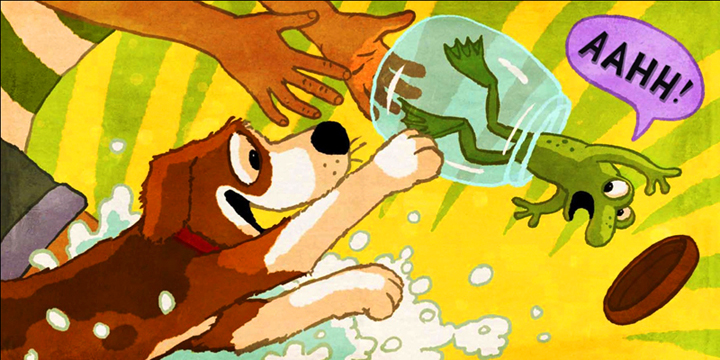
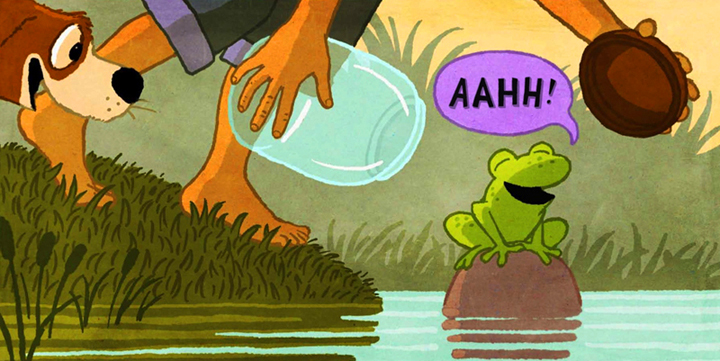
I tried this process again with Ah Ha!. But I found that after cutting out the text that describes the action and pictures, I ended up with almost nothing. I decided again to focus on how the characters were feeling and discovered that I could write the whole book with only two letters “A” and “H.” So you have “AHHH!” in one scene and “AAHH!” spelled the exact same way in another, but one is a scream and the other is a sigh. You have to look at the expressions on the characters' faces and the action in the pictures. So it’s a good way to teach kids about context and inflection.
Many kids with autism have a flat affect, and my son Harry is like this. He sounds a little robotic when he talks. But it’s so hard to teach inflection. So Ah Ha! is a very interesting and useful book because he can decode it, no problem, but you need a lot more careful comprehension to read it, because it’s all in how you say the words.
That’s definitely the intention there. It’s about trying to put the right kinds of emotion into what you are reading.
Can you tell me more about your lettering? One of the ways that you communicate how to read things and what the emotion is isn’t just the look or expression on a character’s face, but also the actual typography. Do I have that right?
Yes. For a lot of the books that’s true. "Ah Ha!" was hand-lettered.
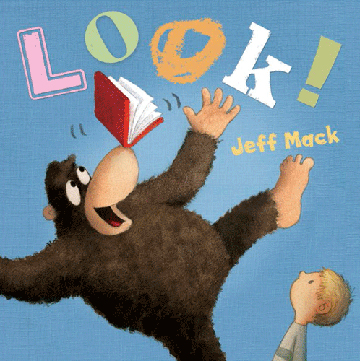
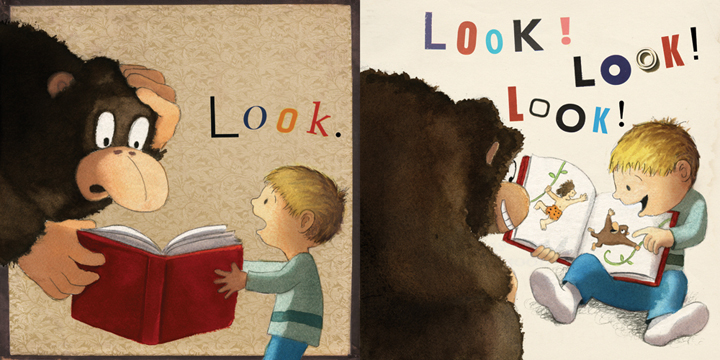
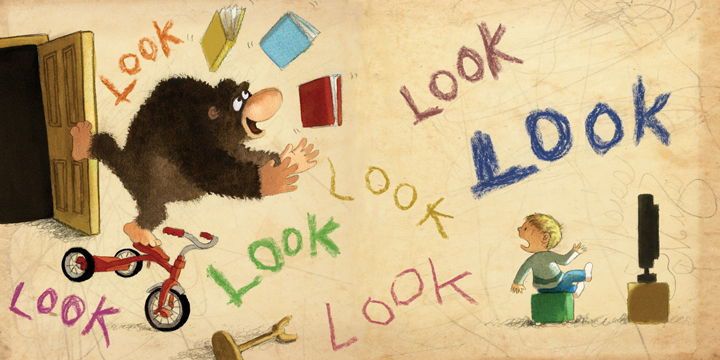
Look! and Playtime? both have interesting typography. Because I don’t use a lot of speaker attribution ("he said" or "she said"), I have to find a way to indicate who is speaking. In Look!, the Gorilla is supposed to be a childlike character and the kid is supposed to be like an adult character. So to indicate that, I wrote the word, "Look!” in crayon with my non-writing hand, and used that for every time the Gorilla speaks. And then I used my computer to merge that with the image so it looks like someone had written on the book. For the boy, I cut letters out of a magazine and glued them together, kind of like a ransom note, so it has a bit more of an advanced or sophisticated note when he speaks.
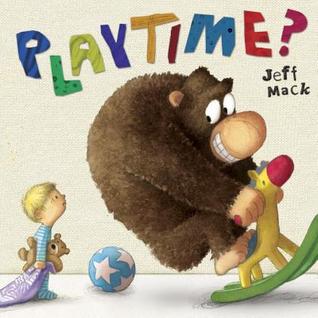
Playtime? is the same kind of thing. Because the backgrounds weren’t made from hard or flat materials, but instead from fabrics connected to bedtime, like pajamas and blankets, it didn’t work so well when I tried to draw on, say, a bed sheet with crayon. So I had to find different ways to communicate the same personality. I got that childlike look for the Gorilla's dialogue by cutting up different colored construction paper and gluing those pieces on the background. For the boy, I found letters that had this embroidery treatment and I arranged them similarly to how I did the magazine cutouts in the first book.
It’s definitely meant to be subtle. I think those little details contribute, but I don’t want to make that my main focus.
It’s tricky because a lot of kids with autism are really obsessed with letters. My kids pick up on those kinds of details. If the letters are interesting, they are really noticing them.
I worked for awhile as an animator and I got used to this idea that it takes an incredible amount of work to produce something really short. The effect is to make it look kind of kind of effortless. So I’m so glad to hear that they notice!
A lot of the time in your books you have two highly contrasted characters playing off each other. I first started to really pick up on this with Good News, Bad News, where you have the rodent being a pessimist about everything and the rabbit as an unfailing optimist.
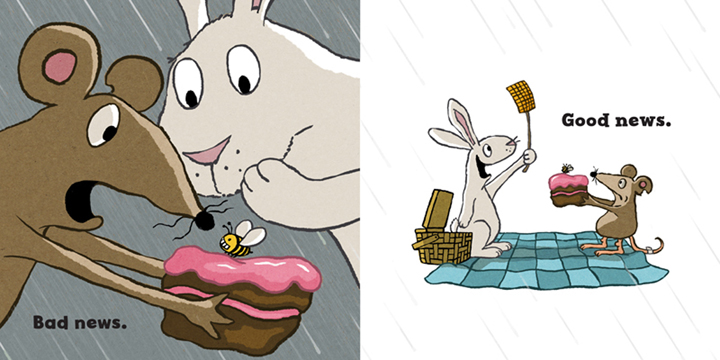
But then I realized it was all your books! You have the predator and prey relationship in Frog and Fly. You’ve got a friendly, affectionate bear up against a very grumpy and introverted skunk in Who Wants a Hug? and Who Needs a Bath?. And finally, you have the parent/child relationship bringing the character conflict in Look! and Playtime?. Those are the books I’m the most familiar with. Does that just happen to you? Or do you start off saying, okay I’m going to have two contrasting characters—who are they?
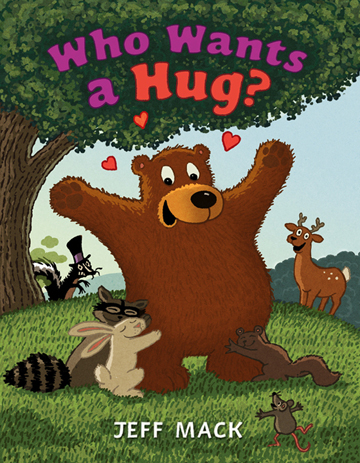
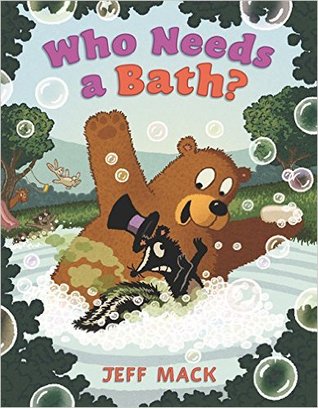
Yeah, I don’t know how strategic I am in terms of saying, ok, I need a conflict here so I will choose two opposite characters so they have something to fight about. It probably happens more organically. Usually when I start off, it’s stick-figure scribbles in a notebook. I start with the problem of the story; that’s what I know before I know who the characters are going to be. And it seems that it just naturally works out for me that my characters are opposites.
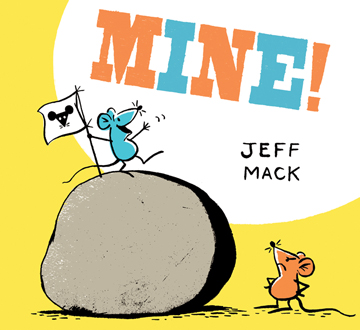
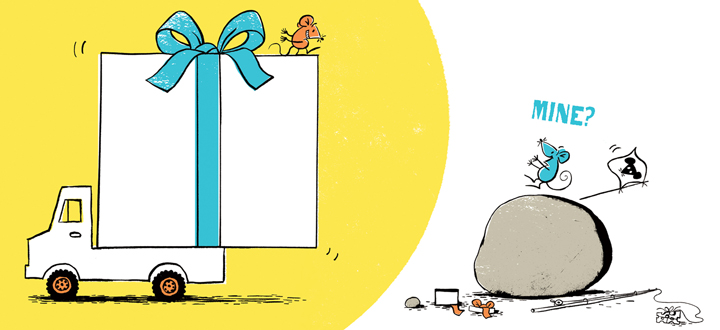
I have this new book coming out called Mine!. In this book the characters are essentially twins. They have the same goals. So I was trying something a little different with that. That shared goal, what they want, excludes each other. But if it wasn’t for their colors being different, you wouldn’t be able to tell the two characters apart.
So they are both fighting over the rock I see on the cover?
Yeah. They both want it and they both want it for themselves. And they really can’t see each other’s point of view.
I wanted to ask you about physical comedy. All of your books are funny.
Thank you.
Well they are! You have things getting stunk up, and they get muddy, and they get electrocuted, and there are bees chasing them, and they get hit by swatters, they crash into things. My son Luke is a huge physical comedy fan. So this is the thing that draws him most into your books. So tell me about that. Are you a Three Stooges kind of guy?
I’m probably more of a Chaplin fan. I’m not a huge fan of violence, but I guess there is some violence in my books.
Yes, yes there is.
It’s the kind of thing that draws kids in and gets them laughing. You know when I read Frog and Fly to kids, the part where he crashes into the tree always gets a huge laugh. And it’s such a simple thing. But it’s important that there is an emotional connection too. Usually when a character is getting beaten up, I’m hoping that I’m also creating sympathy around the character too. The skunk, for instance, at the end of Who Wants a Hug?, he's not really such a bad guy. His tricks keep going wrong, and he finally realizes that his strategy isn’t working.
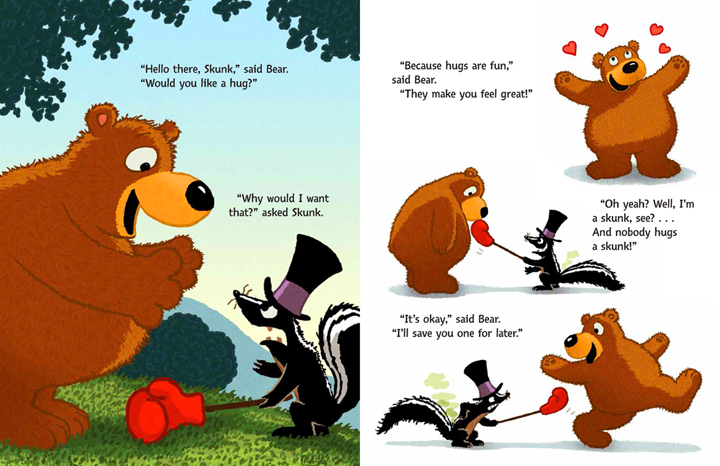
I think there are a lot of kids out there who can relate to Skunk. So the skunk doesn’t want to be hugged. Lots of kids don’t want to be touched or hugged by strangers or even by people they know. And there are certainly a lot of clickbait-y parenting articles out there about the importance of teaching kids that they don’t have to give a hug to anyone they don’t want to; and that’s about consent. I think your book fits into this discussion really well.
Yeah, that’s a really good reading of that. And if kids get that, great. And if they are just at the level where they like the characters and enjoy it when the skunk gets smacked with a fish, that’s okay too. The main thing is just that it’s a fun book for kids.
You answered a lot of the questions about Frog and Fly that I was going to ask. I was going to ask if you are a comic book fan; you are. For someone reason I always think of Bazooka Joe when I read Frog and Fly.
Makes sense. Actually, when I wrote that it was just six little one-liner jokes, and I thought, maybe I can make six little books out of it? I had some friends who thought I should just give it away for free on my website. But when Philomel published it, they wanted to try to find a way to put all six stories in one book. It was pretty interesting.
It’s my favorite of your books to be quite honest. I think those six stories work so well together. Variations on a predator/prey theme. Great repetition. That sixth story turns the plot circle on its head with frog becoming prey, which is so much fun. It’s a graphic novel gateway drug for preschoolers.
So now I have to ask you about the gorilla and the boy’s relationship in Look! And Playtime?. Obviously you’ve inverted the parent/child relationship, as you’ve said, and the boy is dealing with how Gorilla won’t go to bed. So was the idea there that you wanted kids to have empathy for their parents? Why that play?
It’s a relatable problem. And I thought there might be a way for parents and children to share this book and see each other’s points of view. I mean, I didn’t like to take a nap when I was a kid.
In Look! You seem to be taking on screen time. I don’t know if you have read about this, but there has been some recent research about how kids with autism are more susceptible to tech addiction and negative psychological effects from screen time. So it’s an issue that I think a lot about. On the other hand, many kids with autism use screens therapeutically; mine do as part of reinforcement strategies in ABA. There are also kids my sons go to school with who use their iPad as communication devices since they can't speak; so those children need to have a screen all day.
What is your intended message with Look!?
Originally, it was a story about a bear in the woods who juggles. He comes across some kids having a picnic and the kids are just terrified of him. I kept working on it, and I realized that the main problem was the problem of getting attention. People will do really positive things to get attention and really negative things to get attention. So I wanted my character to be on a quest for attention.
I decided that the problem didn’t have enough of a concrete, relatable situation. So I tried to think about the things that compete for attention in the home, and I thought about TV. I remembered all the times I was a kid and one of my parents was watching TV and I wanted them to pay attention to something I was doing. And then there are all the situations when a parent wants to get a kid's attention, but they are focused on a screen. So I changed the story to be about that.
I also added the possibly controversial topic of books versus TV. I wanted to show that books are something that we can communicate and connect over. Not that you can’t connect over a TV show. But when you watch a TV program, each person is in their own personal space. So I thought books were a satisfying solution to the problem posed by TV in the story.
Oh, and I changed the bear to a gorilla. I’m glad I did too. I can’t explain why but it works better.
Plus you already had a bear in Who Wants a Hug? and Who Needs a Bath?.
Yes. I didn’t want any confusion.
Speaking of animal confusion, I was absolutely convinced, and so are my sons, that the mouse in Good News, Bad News was a rat until you said "mouse" earlier in this interview. Must be my New York perspective.
Well… You know, I think I’ve been conditioned to say "mouse" from so many school visits. Rats get such a negative reaction! But yeah, it’s a rat.
I knew it! Last question. Can you tell me about the children’s books that have inspired you?
I love William Steig; his books like Amos & Boris, The Amazing Bone, and Sylvester and the Magic Pebble. I’ve loved them ever since I was a kid.
I also loved Dr. Seuss when I was a kid, but maybe not as much as an adult.
I really like Ed Emberly. I love his Drawing Book series, the way he would take these really complicated scenes, like a whole battle scene between some ships, and show you how to break it down one line or simple shape at a time. I think that’s just a big metaphor for life. Or for any task that seems daunting. You just have to stay focused on each step. That was really inspiring to me.
I read a book several years ago called The Secret Diary of Adrian Mole, Aged 13 3/4 by Sue Townsend. That was a big inspiration for me in writing my Clueless McGee series, which is a chapter book series for grades 2-5.
Oh, and Bill Peet! He was a Disney character designer. He did a lot of the big animated features: The Jungle Book, 101 Dalmations, and quite a few others. And he also wrote and illustrated many amazing picture books too.